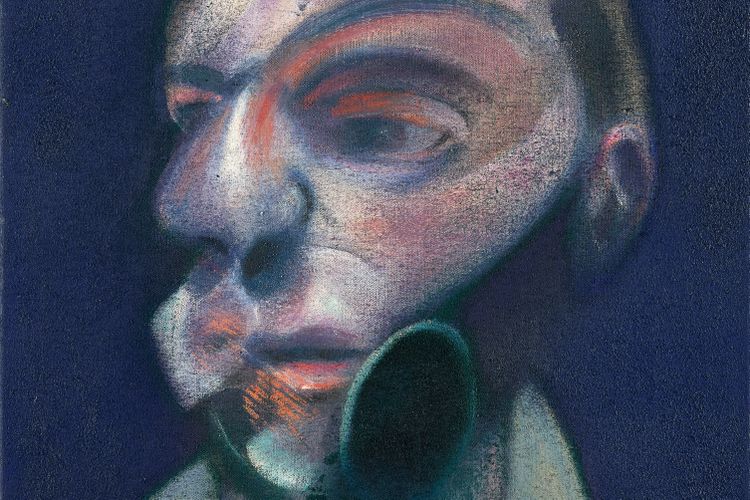ART WORLD NEWS
Flipping the Bacon: Sotheby’s £69m post-war and contemporary sale lacks fizz
[ad_1]
Francis Bacon’s 1975 portrait sold for £16m (with fees), only a £1.2m return since it was last sold four years ago.
Sotheby’s
There was a lack of fizz at Sotheby’s post-war and contemporary sale in London last night— literally and figuratively.
Gone were the usual glasses of champagne being handed out at the entrance to the sale room, forcing thirsty clients to forage for refreshments elsewhere. Could this be a sign of things to come under Sotheby’s new owner Patrick Drahi, a French-Israeli telecommunications entrepreneur who has a reputation for sharp cost-cutting?
The sale itself was solid, if unremarkable. It brought in £58.4m (£69.6m with fees), just above the low pre-sale estimate of £58m, but down almost 40% on last year. The sell-through rate was a decent 90%.
Profit margins will be squeezed by the 16 lots guaranteed by third parties, with several items selling on a single bid to the financial backer. They included sculptures by Louise Bourgeois and Donald Judd, as well the most expensive lot of the night, if not week: Francis Bacon’s small but penetrating 1975 self-portrait, which fetched £14.35m (£16.5m with fees)—more on that price later.
However, Sotheby’s will cash in nicely from the only lot guaranteed in house: an unusual painting by the enigmatic German artist Otto Wols who died aged 38 of food poisoning. Vert Strié Noir Rouge (Green Stripe Black Red) (1946-7) sparked what the sale’s auctioneer Ollie Barker called the “bidding competition of the night”, vaulting 7.5 times over its high estimate to sell on the phone for a record £3.8m (£4.5m with fees) to Sotheby’s head of Impressionist and Modern art, Helena Newman. Underbidding came from a dogged Japanese client.
Unlike Christie’s sale on Tuesday evening, which tended towards fresh material by young artists, Sotheby’s stuck to a more tried and tested auction format. “Our sale was a bit more classical, it was really the great artists we know and love,” said the head of sale Emma Baker.
But even blue-chip artists are not immune from being flipped. The Bacon self-portrait last sold at Sotheby’s in London in July 2015 for £15.3m with premium, just before the market faltered. By art market standards, £1.2m over four years for such an artist is a poor return.
Profits were slim where Robert Ryman and Rudolph Stingel were concerned, as Bloomberg’s Katya Kazakina pointed out. The seller of Ryman’s 1963 oil on a scrap canvas, Untitled #32, paid $1.1m at Christie’s Paris in 2017, but sold it for $1.08m last night, after trying to offload it at Lévy Gorvy last summer for $1.8m. Meanwhile, even Stingel’s exhibition at the Fondation Beyeler in Basel could not lift his prices. His untitled oil and enamel on linen from 2012 went below estimate for $1.3m ($1.6m with fees) on a single bid to Gagosian, having fetched $2.9m at Christie’s Hong Kong in 2017.
Otto Wols, Vert Strié Noir Rouge (Green Stripe Black Red) (1946-7)
Sotheby’s
Gagosian has been heavily promoting another of its artists, Albert Oehlen, and that strategy paid off last night, with a record for his disconcerting and rare self-portrait with flaming orange background. Selbstportrait mit Leeren Handen (Self-Portrait with Empty Hands) (1998) has not been on the market for 20 years, prompting three bidders to battle it out over six minutes. In the end, the canvas went to the London dealer Per Skarstedt for £5.35m (£6.2m with fees).
Sotheby’s announced after the sale that it is sponsoring a major show of Oehlen’s work at the Serpentine Gallery in London this October.
Women accounted for nearly 20% of Sotheby’s March contemporary sale in London, but in last night’s auction, less than 12% of lots were by female artists. Emma Baker described it as “the nature of the secondary market to be predominantly male”.
Most prominent and accomplished among them was Jenny Saville’s Shadow Head, executed over a period of six years between 2007 and 2013. It sold to the London dealer Tim Taylor in the room for £3.5m (£4.2m with fees; est £3m-£5m). Acquired from Gagosian in 2014, the canvas is the absolute fleshy antithesis of the heroin chic look worn by Kate Moss in the 1990s, during which time Saville and the rest of the YBAs were taking the art world by storm.
The other woman on the block to garner attention was Toyin Ojih Odutola, whose Compound Leaf, a pensive work on paper from 2017, more than doubled its high estimate to sell for £380,000 over the phone. Works by young black women are proving popular among collectors in search of the “next big thing”, as was seen with Tschabalala Self at Christie’s on Tuesday evening. The question is always one of market speculation.
Phillips picks up the baton this evening with a fine rose-hued collage on canvas by Self, carrying a similar estimate to the Christie’s work.
[ad_2]
Source link













